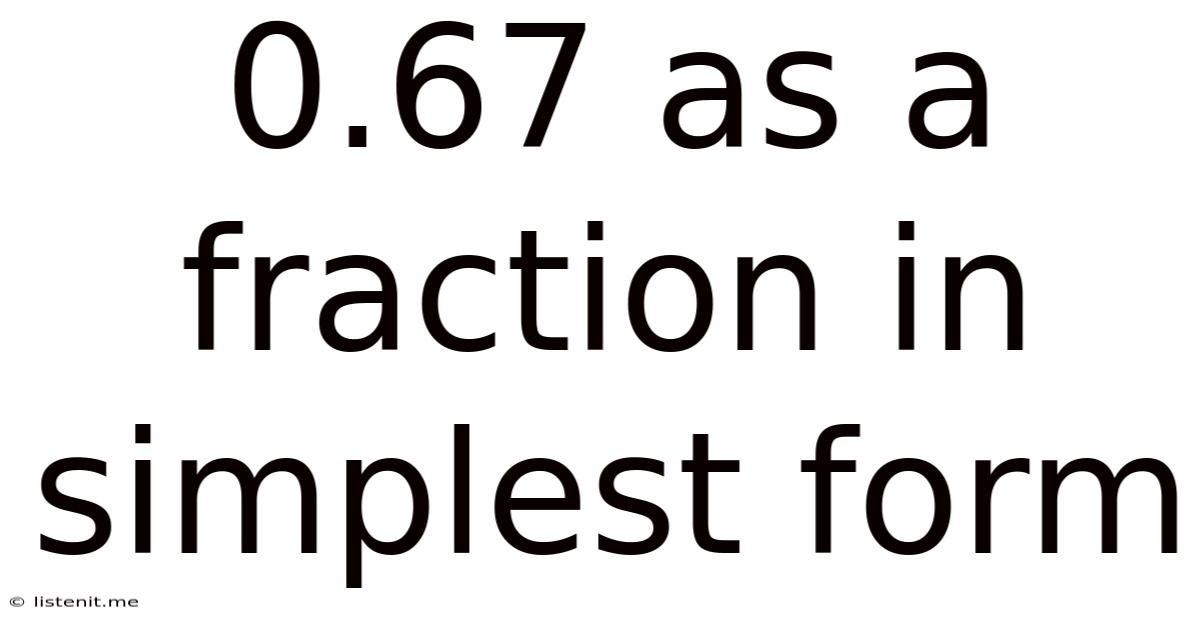0.67 As A Fraction In Simplest Form
listenit
May 25, 2025 · 4 min read

Table of Contents
0.67 as a Fraction in Simplest Form: A Comprehensive Guide
Converting decimals to fractions might seem like a simple task, but understanding the underlying principles and mastering the process is crucial for various mathematical applications. This comprehensive guide will delve deep into converting the decimal 0.67 into its simplest fractional form, exploring the methodology, providing step-by-step instructions, and offering insights into related decimal-to-fraction conversions. We'll also touch upon the practical applications of this conversion skill in diverse fields.
Understanding Decimal to Fraction Conversion
Before we tackle 0.67 specifically, let's establish a strong foundation in converting decimals to fractions. The core principle hinges on recognizing that decimals represent parts of a whole, just like fractions. The decimal point separates the whole number part from the fractional part. The digits to the right of the decimal point represent the numerator of a fraction, while the denominator is determined by the place value of the last digit.
For instance:
- 0.1 represents one-tenth, or 1/10. The denominator is 10 because the 1 is in the tenths place.
- 0.01 represents one-hundredth, or 1/100. The denominator is 100 because the 1 is in the hundredths place.
- 0.001 represents one-thousandth, or 1/1000. The denominator is 1000.
This pattern continues for further decimal places. The denominator is always a power of 10 (10, 100, 1000, 10000, etc.).
Converting 0.67 to a Fraction: A Step-by-Step Guide
Now, let's apply this knowledge to convert 0.67 into a fraction.
Step 1: Write the decimal as a fraction with a denominator of a power of 10.
Since 0.67 has two digits after the decimal point, the denominator will be 100 (10²). The numerator will be the digits after the decimal point, which is 67. Therefore, we can write 0.67 as the fraction 67/100.
Step 2: Simplify the fraction to its lowest terms.
This step involves finding the greatest common divisor (GCD) of the numerator (67) and the denominator (100) and dividing both by it. The GCD is the largest number that divides both the numerator and denominator without leaving a remainder.
In this case, the GCD of 67 and 100 is 1. This means that 67 and 100 do not share any common factors other than 1. Therefore, the fraction 67/100 is already in its simplest form.
Conclusion: 0.67 expressed as a fraction in its simplest form is 67/100.
Exploring Related Decimal to Fraction Conversions
Understanding the conversion of 0.67 helps us grasp similar conversions. Let's explore a few related examples:
1. Converting 0.675:
Following the same steps:
- Step 1: 0.675 can be written as 675/1000.
- Step 2: The GCD of 675 and 1000 is 25. Dividing both the numerator and denominator by 25 simplifies the fraction to 27/40.
Therefore, 0.675 = 27/40
2. Converting 0.676767... (Recurring Decimal):
Recurring decimals require a slightly different approach. Let's denote the recurring decimal as x:
x = 0.676767...
Multiplying by 100:
100x = 67.676767...
Subtracting x from 100x:
100x - x = 67.676767... - 0.676767...
99x = 67
x = 67/99
Therefore, 0.676767... = 67/99
3. Converting 0.7:
This is a simpler case:
- Step 1: 0.7 can be written as 7/10.
- Step 2: The GCD of 7 and 10 is 1, so the fraction is already in its simplest form.
Therefore, 0.7 = 7/10
These examples demonstrate the versatility of the decimal-to-fraction conversion process and its applicability to various decimal types.
Practical Applications of Decimal to Fraction Conversion
The ability to convert decimals to fractions isn't just a theoretical exercise; it holds significant practical value in numerous fields:
- Engineering and Physics: Precise calculations often require fractional representation, ensuring accuracy in measurements and calculations.
- Construction and Architecture: Blueprint readings and material calculations necessitate the use of fractions for precise dimensions.
- Baking and Cooking: Recipes frequently utilize fractions to specify ingredient quantities accurately.
- Finance and Accounting: Accurate representation of monetary values and calculations in financial reports.
- Computer Programming: Dealing with pixel dimensions and screen resolutions often involve fractions.
- Mathematics: Foundation for understanding rational numbers and solving equations.
Advanced Concepts and Further Exploration
For those seeking a deeper understanding, we can explore more advanced concepts:
- Continued Fractions: Representing numbers as a sum of fractions, providing alternative representations for decimals.
- Approximations: Converting decimals to fractions with a specified level of accuracy.
- Irrational Numbers: Understanding the challenges of converting irrational numbers (like pi) to rational fractions.
Conclusion
Converting decimals to fractions, as illustrated by the conversion of 0.67 to 67/100, is a fundamental skill with wide-ranging applications. Mastering this process strengthens mathematical understanding and proves invaluable across various disciplines. Remember the core principles: identifying the place value to determine the denominator, and always simplifying the fraction to its lowest terms using the greatest common divisor. By practicing different examples and exploring advanced concepts, you can build confidence and proficiency in this crucial mathematical skill. The ability to seamlessly convert between decimal and fractional representations significantly enhances numerical fluency and problem-solving capabilities.
Latest Posts
Latest Posts
-
Greatest Common Factor Of 28 And 32
May 25, 2025
-
6 Months From July 29 2024
May 25, 2025
-
How Many Days Since Oct 11
May 25, 2025
-
What Is 1 30 As A Percent
May 25, 2025
-
What Is The Gcf Of 77 And 56
May 25, 2025
Related Post
Thank you for visiting our website which covers about 0.67 As A Fraction In Simplest Form . We hope the information provided has been useful to you. Feel free to contact us if you have any questions or need further assistance. See you next time and don't miss to bookmark.